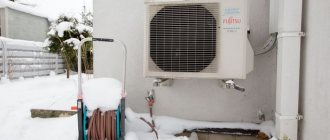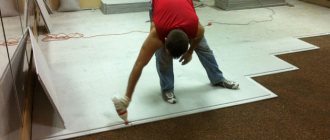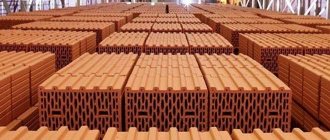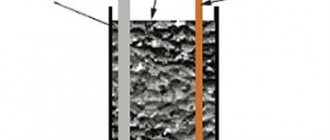Here you will learn:
- Types of convectors
- How it works?
- Electric convector device
- Extra options
An electric convector is an energy-saving heating device that creates optimal room temperature in a room. Low price, reliability in operation, quick set-up and long-term maintenance of a comfortable temperature have allowed convectors to take a leading place in the market of household heating appliances. Let's look at the types, main functions and operating features of these devices.
Types of convectors
The choice depends on how the convector heater works. This is a powerful device for heating large areas or a portable little one for a child's room. Convectors are divided according to installation method into:
- floor-standing – mobile devices that can be placed in any area of the house; they are often installed in offices, shops and shopping centers for quick heating;
- wall-mounted, which are mounted mainly under windows to block cold air, are considered the most energy-saving, most often suitable for home use;
- Built-in baseboards are used to heat large areas where more compact and weaker devices are unprofitable.
Although built-in convectors are considered powerful, they are not used so often. The reason is that such a device for an electric convector requires special planning during the construction of a house or the preparation of niches and grates in the floor for air exchange.
Electric heater power calculation
There are two ways to calculate the power of the device.
By room area
It should be borne in mind that calculating the power of a heating unit by area gives approximate indicators and requires corrections. But it is simple and can be used for quick, approximate calculations. So, based on the established standards, for a room with one door, one window and a wall height of 2.5 meters, a power of 0.1 kW/h per 1 m2 of area is required.
For example, if we take a room with an area of 10 m2 for calculation, then the required power of the unit will be equal to 10 * 0.1 = 1 kW. But it is worth considering some factors. In the case of a corner room, the correction factor will be 1.1. The result found should be multiplied by this number. Provided that the room has good thermal insulation and has plastic (energy-saving) windows installed, the calculation result should be multiplied by 0.8.
By volume
To calculate the power of a heating convector by volume, you need:
- calculate the volume of the room (width*length*height);
- the found number must be multiplied by 0.04 (exactly 0.04 kW of heat is needed to warm up 1 m3 of room);
- Using coefficients, clarify the result.
Due to the fact that the height of the room is also used in the calculation, the power calculation will be more accurate. For example, if the volume of the room is 30 m3 (area 10 m2, ceiling height 3 m), then 30 * 0.04 = 1.2 kW. It turns out that for this room you will need a heater with approximately a power slightly higher than that found.
For a more accurate result, power should be calculated using a coefficient. If there is more than one window in the room, then for each next one, 10% is added to the result. This figure can be reduced if the walls (floors in a private house) are well insulated.
As an additional source of heating
If the main heating is not enough during severe frosts, then an electric convector is often used as an additional source of thermal energy. The calculation, in this case, is made as follows:
- when calculating the indicator by area, 30-50 W are required for each square meter;
- when calculating by volume, 0.015-0.02 kW is required per 1 m3.
How it works?
An electric convector creates air circulation in the room, warming it up.
Regardless of the model or type, the operating principle of an electric convector is as follows: a flow of cold air is heated by passing through a hot surface (usually a heating element). The warm air flow rises, and when it cools, the air falls and goes through a new cycle .
Where to install
The convector is silent in operation, maintains precise temperature, does not burn or dry out the air, so it is excellent for home use. Since the device is afraid of drafts and rooms with poor insulation, the optimal solution is a bedroom, children's or guest room. Here the heater will provide a smooth temperature increase and maintain it for a long time in an economical mode. We do not recommend installing this equipment in warehouses, summer houses, garages, where there are drafts, uninsulated walls and windows that make the operation of the convector pointless .
Please note that for uniform temperature distribution and comfortable thermoregulation, it is important to choose the right installation location. Most often, convectors are mounted under a window, which allows them to neutralize the flow of cold air. For rooms with high ceilings, additional ceiling fans are used.
Principle of operation
The very word “convector” indicates that the principle of its operation is based on such a physical phenomenon as convection. Cold air, being more dense, is located in the lower layers - near the floor of the room. Having passed through the convector, the air warms up, its density decreases, as a result of which it rises.
Convection can be not only natural, but also forced. The built-in fan will help increase the convection air flow and thereby increase the efficiency of the heating device.
Electric convector device
It is worth mentioning right away that different models may differ in their design in some blocks, but the main elements remain unchanged. So, all electric heaters consist of:
As can be seen from the figure, the operating principle of an electric convector and its design are quite simple.
- body made of metal;
- heating element (heating element);
- various sensors (temperature, convector position, overheating sensor);
- control panels;
- thermostat;
- gratings.
The body is usually made of light alloy metal. It performs a protective function and is made lightweight specifically to reduce the weight of the product. Two gratings are inserted into it. One of them is located below. Through this hole, cold air is sucked in by the convector. The second is located in front of the heater in its upper part. Already heated air exits through it.
Air can enter the electric heater either naturally (convection, when air rises when heated) or forced. Fans are often installed in devices to increase the air supply, thereby increasing the efficiency of the convector. This operating principle of convector heaters reduces the load on the heat exchanger, which increases the reliability and durability of the device.
The temperature sensor is installed in the lower part of the heater. Typically, it takes a temperature measurement every 45 seconds, after which a signal with the result is sent to the control unit , where the electronic thermostat turns the device on or off (depending on the sensor readings).
Types of heating elements
The heart of the convector is the heating element. Electric models typically use three types of heating elements:
- monolithic;
- tubular with aluminum fins;
- needle.
It is recommended to install models with a monolithic heating element in the bedroom, as they do not make any sounds and will not interfere with rest.
A special feature of a heater with a monolithic heating element is its noiselessness. In this case, the body is made solid (cast). The heat loss of this device is minimal, so it has a high efficiency rate.
In the case of a tubular heating element, the heating element is a steel tube in which a nichrome thread is stretched, and the internal space is filled with insulating backfill (heat-conducting). Fins made of aluminum are fixed to the tube, which provides the device with high heat transfer and increases the degree of convection. Heaters of this type have a long service life and can be installed in the bathroom, but sometimes they make a cracking noise.
Needle heating elements consist of a dielectric thin plate on which a heating chrome-nickel filament coated with insulating varnish is installed. Convectors with such a heating element heat up and cool down almost instantly , but they should not be used in rooms with high humidity levels. The main advantage of devices with needle heating elements is their affordable price, but they cannot be called durable.
Convector electrical circuit
As can be seen from the figure, the circuit of electric heaters of this type is quite simple.
It is enough to connect the device to a 220 V network using a cord, then press the switch button (it completely disconnects the device from the electrical network, so you don’t have to remove the plug, but use the button). The control panel is usually a temperature controller. Also included in the circuit is a safety sensor that opens the circuit when overheated, and a thermostat that turns the convector off or on depending on the ambient temperature.
Difference from radiator
To make a choice between two types of heaters, you need to know the difference between a convector and a radiator. We already know the structure and operating principle of the first device. Now let's examine the radiator.
Design and principle of operation
A radiator is a hollow metal structure filled with coolant. In electric models this is mineral oil, in central heating systems it is water. But we are only interested in oil (electric) radiators.
A heating element is located inside the cavity. First, it heats up itself, then it transfers heat to the oil, which shares thermal energy with the body. Only then does the air, touching the heated metal, become warm, and it floats up. Here we are also talking about convection, but the heating path is too long and expensive.
Extra options
Regardless of the type of device, convectors have the following additions to facilitate setup and operation:
- The electric sensor ensures safe use and monitors the permissible temperature. This element is activated and turns off the device when the maximum temperature is reached. After cooling, the sensor automatically starts the device. More advanced models also have a built-in tip-over sensor - if the device is overturned, the system turns off .
- Thermoregulator is a mechanical or programmable element that controls the heating temperature. Most often presented in the form of a mechanical wheel.
- A screen or air grille is a movable or stationary structure that directs a warm flow to the desired area.
- The fan is installed on powerful models to increase heating efficiency and deliver warm air to the largest possible area.
Pros and cons of using it at home
A convector heater does not require special permission for operation.
There are many positive aspects that make it worth buying a convector for a house or apartment:
- There is no need to obtain permits for operation if it is an ordinary electrical device.
- Easy to install. The convector on legs is installed in the right place and plugged into an outlet. There are wheels for moving.
- Adjustable temperature. Some models have built-in sensors that support the desired operating mode.
- Silent - can be turned on around the clock.
- Compact dimensions allow convectors to be installed in small spaces.
- They do not burn oxygen, since the temperature inside the heating element does not exceed 65 degrees.
- Economical. They are cheaper than oil radiators, but the efficiency is much higher. When no one is home, the heater can be set to a lower temperature.
- The low cost allows you to install several devices in one room, if necessary.
- The devices are fireproof and have overheating protection.
- You can purchase a convector heater with a protective screen with adjustable air flow directed to a specific area.
This type of heating has few disadvantages. Higher power devices will require more electricity. The inconvenience may be associated with the installation of in-floor convectors, the grille of which is at the same level with the coating - debris will fall inside the unit. If the room is dusty, dust particles will constantly float in the air due to circulation. The apartment will have to be wet cleaned more often.
Heater with remote control
Additional equipment can be connected to this type of device:
- humidifier;
- timer;
- thermostat for precise temperature control;
- remote control to turn on devices remotely.
Additional equipment is usually not included with the device. If necessary, it can be purchased separately.
Safety
An important factor when choosing a convector is the safety of its operation.
And although such devices are not capable of causing a burn to a person, since the body does not heat up to a traumatic temperature, there is, however, the possibility of accidentally tipping it over.
This is especially true for free-standing convectors.
To eliminate the possibility of a fire from a short circuit if accidentally tipped over, you should purchase devices equipped with a tip-over sensor.
This sensor, if the device overturns, will instantly de-energize it.
You should also take into account the weak level of electrical protection of devices with needle-type heating elements.
Heat sources
To heat a living space, a person uses different heat sources. The most common was hot water circulating in a closed kennel from pipes laid throughout the house.
But the water still needs to be heated before being fed into the pipes. For this purpose, centralized heat supply is used in multi-storey buildings.
In this case, there is a separate boiler plant, where combustion of gas or coal is used for heating.
In private homes, autonomous gas heating is more often used, where a small gas boiler is used to heat water, providing heat only to the house in which it is installed.
It’s just that with centralized heating, certain deadlines are set for providing heat to the house, and the heat supply itself wants to leave the best.
In the private sector, there are times when the house is cool and you don’t want to start the boiler.
In this case, electric heaters come to the rescue. Although they consume a significant amount of electricity, since they have significant power, they are able to quickly heat any room in the house.
There are a large number of types of electric heaters, from simple spiral heaters, popularly nicknamed “goats,” to modern infrared and convector heaters.
The latter are becoming increasingly popular these days.
Frame
When choosing a convector, you should also pay attention to the housing.
Firstly, you need to take into account the height of the device; the speed of air movement inside the housing depends on it, which ultimately affects the efficiency of its operation.
A convector with a height of 50 cm is considered optimal. This criterion also applies to floor convectors, but it is not its height that is taken into account, but its width.
Secondly, you need to take into account the thickness of the walls of the housing, because its walls also participate in heat exchange. Therefore, the thicker the walls of the housing, the higher the heat transfer will be, which means the efficiency of the device itself will be higher.
Review of popular brands
Models of electric convectors are produced by manufacturers in different countries of Europe, Asia, and America.
Let's name just a few of them:
- Arbonia . A Swiss-German company producing steel pipes, heating radiators, heated towel rails and convectors. The company's product range is extremely extensive, and almost all products can be purchased in Russia. The offered models of convectors are very diverse: they have different shapes, colors and sizes. The company also accepts orders for non-standard products, such as corner units.
- Buderus . The German brand, now part of the Robert Bosch GmbH concern, originated in the first half of the 18th century. Initially, the company produced cast iron elements for making hearths, and from the beginning of the 20th century it began producing heating devices, including those powered by electric current. The company produces highly efficient, high-quality convectors that combine high technical characteristics and attractive appearance. In 2012, the company was awarded the Red Dot Award, awarded for achievements in the field of design.
- Kermi . The start of production of this German company dates back to 1960. The company produces various types of products, including shower cabins and heating equipment, but it is convectors, widely represented in Russian stores, that are the hallmark of the company.
- Purmo . The company, founded in the Finnish town of the same name, has been producing heating devices that can withstand the cold climate of the northern country since the late 1950s. In the early 1970s, after the company became part of the Rettig concern, production was significantly modernized and automated. Now the company's products are known all over the world: they are exported not only to European countries, but also to other continents.
- Zehnder . The Swiss company, created at the end of the 19th century, specializes in the production of luxury products. Its range includes heated towel rails, radiators and convectors of various types (ceiling, floor, wall), having a truly “cosmic” design. In addition to serial products, the company produces custom models, taking into account the individual requirements of clients.
In addition to the above companies, convectors from the French company Noirot, Norwegian Nobo, German Stiebel Eltron, Roda and other companies are popular.
Still can't decide on the choice of convector for your home? We recommend that you read the tips on choosing heating devices, which are given in our other article.
Convection heaters
Now we will answer the question of what a convector type heater is. A convector is a device that uses convection, in most cases natural, in its operation. The basis of the design of each device is:
- Housing - it is designed to protect people from accidental contact with live or hot parts. It also plays a decorative role. The body contains controls, indicators and information screens;
- Heating element – in convection heaters it can be electric, gas or water. It is he who is responsible for heating the air in the rooms;
- Thermostat - it can have a very different design.
All convection heaters are extremely simple, there is nothing complicated or supernatural about them. Thanks to this, they have earned such popularity.
The convector design is distinguished by its simplicity, and this is a sure sign of reliability.
They work very simply - when you turn on the gas, supply hot coolant or electricity, the ribbed heating element heats up, which begins to warm up the air. Air masses become lighter as they travel upward. This process is closely monitored by automation that regulates heating. At the same time, cold air enters the convectors, which envelops the heating element - the cycle repeats.
As soon as the air temperature sensor sees that the heating level has reached the specified limit, it will give a command to turn off the heating element. As soon as the air cools below the set norm, the thermostat will work and give a command to activate the device. Thus, convectors ensure the maintenance of stable air temperature in the premises.
In water convectors, temperature control is carried out using a special thermostatic valve-regulator.
heating elements
Next you should pay attention to the heating elements. Needle-type heating elements, where the spiral is not protected by anything and is fixed on a thin plate, are very fragile; a small blow to the body is enough for the spiral thread to break.
But such convectors are much cheaper than with other types of heaters.
The most reliable and durable are monolithic heating elements. They are not afraid of shocks and can even withstand the device being tipped over. However, the cost of devices with heating elements is much higher.
The choice of monolithic heating elements is also supported by the operation of the convector itself.
Needle-type heaters may crackle slightly during operation, while monolithic heaters are absolutely silent.











